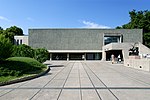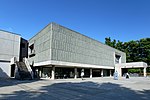Japan Academy
Extraordinary organs (Japan)Government agencies established in 1879Japan AcademyNational academies of sciencesUeno Park

The Japan Academy (Japanese: 日本学士院, Nihon Gakushiin) is an honorary organisation and science academy founded in 1879 to bring together leading Japanese scholars with distinguished records of scientific achievements. The Academy is currently an extraordinary organ of the Ministry of Education, Culture, Sports, Science and Technology with its headquarters located in Taito, Tokyo, Japan. Election to the Academy is considered the highest distinction a scholar can achieve, and members enjoy life tenure and an annual monetary stipend.
Excerpt from the Wikipedia article Japan Academy (License: CC BY-SA 3.0, Authors, Images).Japan Academy
Taito
Geographical coordinates (GPS) Address Phone number Website External links Nearby Places Show on map
Geographical coordinates (GPS)
| Latitude | Longitude |
|---|---|
| N 35.716111111111 ° | E 139.77722194444 ° |
Address
日本学士院
110-0007 Taito
Japan
Open on Google Maps










